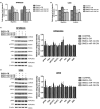Targeting of stromal versican by miR-144/199 inhibits multiple myeloma by downregulating FAK/STAT3 signalling
- PMID: 31532704
- PMCID: PMC6948970
- DOI: 10.1080/15476286.2019.1669405
Targeting of stromal versican by miR-144/199 inhibits multiple myeloma by downregulating FAK/STAT3 signalling
Abstract
The abnormal growth of malignant plasma cells in Multiple Myeloma (MM) requires bone marrow (BM) niche consisting of proteoglycans, cytokines, etc. Versican (VCAN), a chondroitin sulphate proteoglycan promotes progression in solid tumours but there is dearth of literature in MM. Hence, we studied the involvement of VCAN in MM and its regulation by microRNAs as a therapeutic approach. Thirty MM patients and 20 controls were recruited and BM stromal cells (BMSCs) were isolated by primary culture. Molecular levels of VCAN, miR-144, miR-199 & miR-203 were determined in study subjects and cell lines. The involvement of VCAN in myeloma pathogenesis was studied using BMSCs-conditioned medium (BMSCs-CM) and VCAN-neutralizing antibody or microRNA mimics. Elevated expression of VCAN was observed in patients especially in BM stroma while microRNA expression was significantly lower and showed negative correlation with VCAN. Moreover, BMSCs-CM showed the presence of VCAN which upon supplementing to MM cells alter parameters in favour of myeloma progression, however, this effect was neutralized by VCAN antibody or miR (miR-144 and miR-199) mimics. The downstream signalling of VCAN was found to activate FAK and STAT3 which subsides by using VCAN antibody or miR mimics. The neutralization of oncogenic effect of BMSCs-CM by VCAN blockage affirms its plausible role in progression of MM. VCAN was observed as a paracrine mediator in the cross-talk of BMSCs and myeloma cells in BM microenvironment. Therefore, these findings suggest exploring VCAN as novel therapeutic target and utilization of microRNAs as a therapy to regulate VCAN for better management of MM.
Keywords: Multiple myeloma; bone marrow microenvironment; microRNAs; therapeutics; versican.
Figures







References
-
- Palumbo A, Anderson K.. Multiple myeloma. N Engl J Med. 2011. March 17;364(11):1046–1060. - PubMed
-
- Bray F, Ferlay J, Soerjomataram I, et al. Global cancer statistics 2018: GLOBOCAN estimates of incidence and mortality worldwide for 36 cancers in 185 countries. CA Cancer J Clin. 2018. November;68(6):394–424. - PubMed
-
- Rahmani M, Wong BW, Ang L, et al. Versican: signaling to transcriptional control pathways. Can J Physiol Pharmacol. 2006. January;84(1):77–92. - PubMed
Publication types
MeSH terms
Substances
LinkOut - more resources
Full Text Sources
Other Literature Sources
Medical
Miscellaneous
